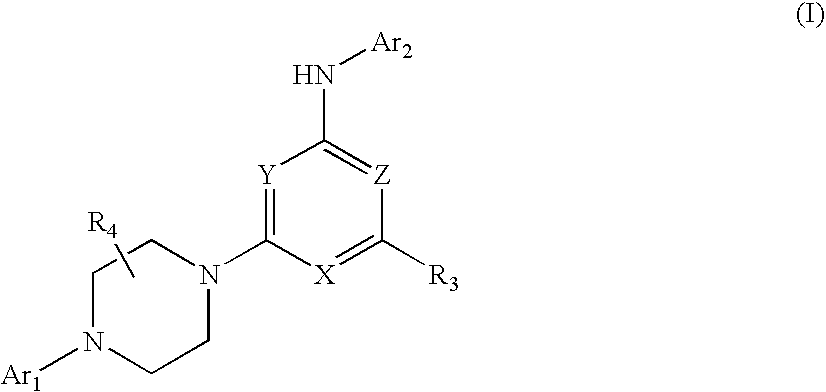Substituted heterocyclic diarylamine analogues
a diarylamine and heterocyclic technology, applied in the field of substituted heterocyclic diarylamine analogues, can solve the problems of acute or chronic pain, more debilitating, and damage to the nervous system
- Summary
- Abstract
- Description
- Claims
- Application Information
AI Technical Summary
Benefits of technology
Problems solved by technology
Method used
Image
Examples
example 1
Preparation of (4-Fluoro-phenyl)-[2-morpholin-4-yl-6-(4-pyridin-2-yl-piperazin-1-yl)-pyrimidin-4-yl]-amine
[0204] This Example illustrates the preparation of the representative substituted heterocyclic. diarylamine analogue (4-fluoro-phenyl)-[2-morpholin4-yl-6-(4-pyridin-2-yl-piperazin-1-yl)-pyrimidin4-yl]-amine.
1. 6-morpholino-2,4-dichloropyrimidine
[0205] To an ice-cold solution containing 2,4,6-trichloropyrimidine (8 g, 44 mmol) in methanol (80 mL) and NaHCO3 (10 g) add slowly and dropwise a methanolic solution (20 mL) of morpholine (4 mL, 46 mmol). Allow the mixture to warm to 25° C. and stir overnight. Dilute with water, vigorously stir for 1 hour, and filter to give a white crystalline solid as a mixture of regioisomers. Carefully recrystallize from toluene to give 6-morpholino-2,4-dichloropyrimidine. Concentrate the mother liquor and carefully recrystallize from EtOH to give 4,6-dichloro-2-morpholinopyrimidine.
2. 4-[4-Chloro-6-(4-pyridin-2-yl-piperazin-1-yl)-pyrimidin-2-...
example 2
Preparation of Additional Representative Compounds
[0208] This Example illustrates the preparation of additional representative substituted heterocyclic diarylamine analogues.
A. 6-[4-(3-Chloro-Pyridin-2-yl)-Piperazin-1-yl]-N,N-Diethyl-N′-(4-Fluoro-Phenyl)-[1,3,5]Triazine-2,4-Diamine
[0209]
[0210] To a rubber-septum-capped vial containing (4,6-dichloro-[1,3,5]triazin-2-yl)-diethyl-amine (0.2 M in toluene, 0.10 mL) and 4-(6-chloro-2-pyridyl)piperazine (0.2 M in toluene, 0.11 mL), add N,N-diisopropylethylamine (1 M in toluene, 0.05 mL). Heat the mixture at 60° C. for 0.5 hours. After cooling, remove the volatiles by evaporation in vacuo (40° C. at 2 torr) and add 4-fluoroaniline (0.2 M in toluene, 0.11 mL). Charge the reaction vessel with argon. Add 0.05 mL of 0.01M palladium solution prepared in situ as follows: mix equal volumes of 0.02 M Pd(OAc)2 in toluene and 0.05 M 2-(dicyclohexylphosphino)biphenyl in toluene. Add potassium tert-butoxide (1M in THF, 0.05 mL) to the reaction mixtu...
example 3
Representative Substituted Heterocyclic Diarylamine Analogues
[0231] Using routine modifications, the starting materials may be varied and additional steps employed to produce other compounds provided herein. Compounds listed in Table I were prepared using such methods. In the column labeled “IC50” a * indicates that the IC50 determined as described in Example 6 is 1 micromolar or less (i.e., the concentration of such compounds that is required to provide a 50% decrease in the fluorescence response of cells exposed to one IC50 of capsaicin is 1 micromolar or less). Mass Spectroscopy data in the column labeled “MS” is Electrospray MS, obtained in positive ion mode with a 15V or 30V cone voltage, using a Micromass Time-of-Flight LCT, equipped with a Waters 600 pump, Waters 996 photodiode array detector, Gilson 215 autosampler, and a Gilson 841 microinjector. MassLynx (Advanced Chemistry Development, Inc; Toronto, Canada) version 4.0 software was used for data collection and analysis. ...
PUM
 Login to View More
Login to View More Abstract
Description
Claims
Application Information
 Login to View More
Login to View More - R&D
- Intellectual Property
- Life Sciences
- Materials
- Tech Scout
- Unparalleled Data Quality
- Higher Quality Content
- 60% Fewer Hallucinations
Browse by: Latest US Patents, China's latest patents, Technical Efficacy Thesaurus, Application Domain, Technology Topic, Popular Technical Reports.
© 2025 PatSnap. All rights reserved.Legal|Privacy policy|Modern Slavery Act Transparency Statement|Sitemap|About US| Contact US: help@patsnap.com



